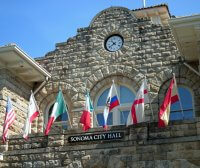 The State Water Resources Board has told the City of Sonoma to cut its use by 28%; the Valley of the Moon water District by 24%. Given the current drought, these target cutbacks make sense; there’s only so much water and it must be conserved. But here’s the rub: both the City of Sonoma Water Agency and the VOM Water Agency need to make a profit and now both will see the sales of their only product drop by a huge amount.
The State Water Resources Board has told the City of Sonoma to cut its use by 28%; the Valley of the Moon water District by 24%. Given the current drought, these target cutbacks make sense; there’s only so much water and it must be conserved. But here’s the rub: both the City of Sonoma Water Agency and the VOM Water Agency need to make a profit and now both will see the sales of their only product drop by a huge amount.
Water agencies need to make profit because they have bills to pay: employees with salaries and benefits, suppliers of water and equipment for transporting it, storage facilities, maintenance and replacement costs, earth-moving equipment, mandated studies and testing…the list goes on. And when a business has bills to pay, it’s ultimately its customers who provide the profits to pay them. That’s business, and herein lays the problem.
Water itself, as is true of air, is basically free. It falls from the sky and accumulates above and underground – at least it used to. Sucked, drained, pulled and pumped, water is a “common pool resource” and its ownership is land-based; if one owns land with water running over or under it, that water is generally removable. Until recently adopted drought-related regulations, no requirements provided that well water extraction be monitored or reported, and these regulations will not even be in full effect until 2042.
Because public water agencies have organized their operations using a business model, profits are an intrinsic element of their operating formula, but in our valley the water agency customers built into this model are almost entirely residential and/or urban commercial users. When agency profits go down water rates have to go up to make up for the lost revenues and thus customers can expect to get hit hard in the wallet for being good water savers.
Those who sink wells and pump water from underground procure their own water. Once a well is sunk and working, well-owners can use as much water as they like, and they do. Thus, though our water agencies are locked into a revenue model which hits individual residential and urban users with fees, well-based residential users and agriculture drawing from the common water pool resource is financially off the hook.
Governor Brown wants water agencies to consolidate for improved efficiency, but it’s not enough. The better solution is a single Valley/City agency whose costs of operating are collectively borne by every land owner in the Valley, including well operators, all of whom would be metered. Thus agricultural users would share the effects of depleting the common water pool, and contribute to the costs of supporting the consolidated agency serving the general public and commercial users. This socialized approach spreads the financial burden of maintaining public infrastructure across the entire community rather than limiting that burden just to paying urban “customers” with metered water hook-ups, as it now. It places water use of every type into proper alignment across the board. Water fees can be calculated and added as an assessment to each property tax bill just as sewage treatment and school related fees are added and collected.
Public water agencies should not be operated as standard profit-making businesses, but as lifeline social services owned by the community which equitably spreads the costs of its provision appropriately between ALL users – urban, rural, piped, well-drawn, commercial, residential and agricultural.







Be First to Comment